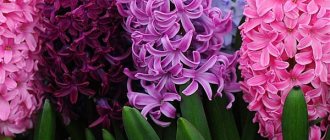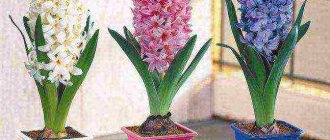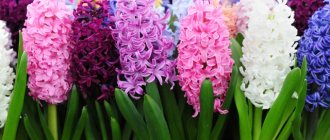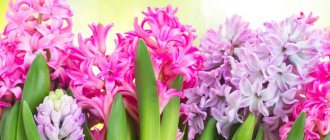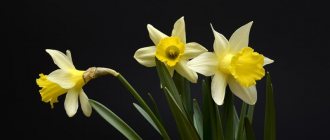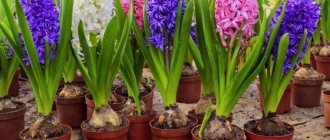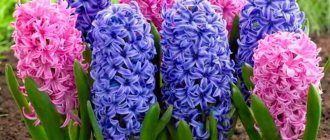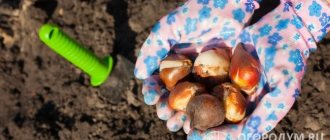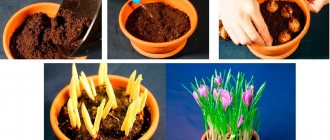Growing hyacinth is not a problem. It is much more difficult to achieve flowering by the desired date. We'll tell you how to make hyacinths bloom for the New Year, Valentine's Day or March 8th.
Hyacinth bulbs are used not only for planting in open ground, but also for forcing at home for the New Year, Valentine's Day and March 8th. Of course, you can not complicate your life and just buy your favorite flower in a pot on the eve of the holiday. But in fact, the process itself is quite simple. In addition, self-grown flowers will be cheaper. And the joy of seeing tender buds bloom cannot be compared with anything!
Hyacinths are easy to force. Even if you make a mistake, you are unlikely to ruin the bulbs. The worst thing that will happen is that flowering will occur earlier or later than planned, and the sultan-inflorescence itself will not stretch enough.
Forcing hyacinths in water
agardenforthehouse.com
Hyacinths can be grown not only in soil, but also in water. This method allows you to get a beautiful flower even faster. However, certain rules still need to be followed.
Firstly, it concerns capacity. It is desirable that this be a special vessel. But if you don’t have one, you can use a regular tall glass.
Secondly, you should not use tap water. It is better to replace it with melted one. Pour the liquid so that, after placing it on the edges of the glass, there is 1.5-2 cm between the bottom of the onion and the water.
Also place the bulbs for forcing hyacinths in water in a cool, dark place, for example, in the refrigerator, where they will spend several months until roots appear. Then move the hyacinth to a warmer place and cover with a cap. The cap can be removed only after the sprout appears.
How to choose a good, healthy plant in the store
Flowers bought in a hypermarket need special care, which is sometimes impossible to provide at home.
The success of growing hyacinth in a pot directly depends on the quality of the seed. In order to avoid mistakes, the following rules are recommended.
- For forcing, bulbs with a diameter of at least 50 mm are used. If hyacinths are to be grown in the garden, finer seeding material will be suitable.
- Depending on the variety, the maximum permissible diameter of bulbs for growing hyacinth in a pot is 40–60 mm.
Requirements for the appearance and quality of seed:
- absence of rot and mechanical damage;
- smooth surface;
- absence of traces of pests and diseases;
- structure that is hard to the touch.
Important! The main criterion for choosing hyacinth for growing in a pot is the ratio of the diameter of the bulb and its bottom. It should be 1.5–1.6:1. For unsuitable seed, this ratio is much lower.
Resuscitation of hyacinth bulbs after forcing
gardeningknowhow.com
Forcing greatly depletes the bulb. Therefore, after the hyacinths bloom, many people prefer to simply throw away the used planting material. But if you put in a little effort, the bulbs can be revived. To do this, follow our recommendations.
- Remove dried inflorescences.
- Fertilize the hyacinth once with fertilizer for bulbous plants.
- Raise the air temperature to 22-23°C and continue to light the flower and water it moderately for a week. This is necessary to activate the process of regeneration bud formation.
- After a week, reduce watering and leave only natural light.
- Stop watering completely when the leaves begin to yellow.
- Place the pots on their side to ensure better flow of nutrients from the green mass to the bulb.
- Remove the bulb from the soil after the leaves have completely died. Dry it and store it at 17°C until planting.
The largest bulbs can be used for re-forcing. But be prepared for the fact that the flowering will no longer be so lush. It is better to plant the hyacinth in the ground so that it can fully regain its strength.
Forcing hyacinths is one of those activities that, once you try it, you can’t stop. After all, their delicate or, on the contrary, bright inflorescences are a real spring miracle, which is so missed during the long winter months.
The most suitable varieties
To force buds by a certain date at home, you need to choose the right varieties according to flowering dates : early - on New Year and Christmas, medium - on Valentine's Day, late - on March 8.
A discrepancy between the expected forcing date and the flowering time of a particular variety will lead to an unfortunate result. The result will be a frail peduncle with unsightly inflorescences, but surrounded by lush, green leaves.
Early flowering
The natural flowering period of early varieties is March. Acceleration of the ripening process shifts the release of the flowering stem to December-January. The best early varieties are :
- Anna Marie;
- Amsterdam;
- Blue Magic;
- Bismarck;
- General;
- Gran Lila;
- Color;
- Delft Blue;
- Ostara;
- Pink Pearl;
- Innocent;
- Marconi;
- Eros;
- Jan Bos;
- Fondant.
This is interesting ! The first successful forcing of hyacinths at the end of December was carried out by the Dutch gardener Dames in 1909. Since 1924, scientists Blau and Leiten have studied the effect of temperature on hyacinth bulbs and provided a scientific basis for the forcing process. The USSR Academy of Sciences has paid attention to industrial forcing of bulbous plants since 1972.
Average
Medium-season hyacinths bloom in open ground closer to mid/late April. You can get fragrant inflorescences by February at home from the following varieties :
- Queen of Blues;
- Amethyst;
- Tubergen Scarlet;
- Gypsy Queen;
- Blue Sky;
- Lady Derby;
- Blue Jacket;
- Orange Bowen.
The Tubergen's Scarlet variety was bred in 1920 by the Dutch breeder I. Hug , named after the heroine of the novel Margaret Mitchell. The color of the terry petals is carmine-scarlet. This mysterious term refers to a rich, fiery red, ruby color.
Late
In nature, late hyacinths bloom in May, but at home you can stimulate the formation of their flower stalks by March. Suitable for forcing for Women's Day:
- Madame Haubensack;
- Snow Crystal;
- Woodstock;
- City of Harlem;
- Anna Lisa;
- Hollyhock;
- Gertrude.
Note ! Hollyhock is one of the latest varieties; it has bright crimson, double, large flowers. The flowering period reaches 20 days at a temperature not higher than 10-15oC.
Choosing a pot
To force hyacinths, it is important to choose the right planting pot. When planting several bulbs, use a wide and low container with a diameter of up to 15 cm. The main thing is to build drainage at its bottom.
Hyacinths. The illustration for the article is used under the standard license ©ofazende.com
Algorithm of actions
The process of forcing hyacinths at home will not seem difficult if you follow the right algorithm of actions.
Bulb selection
Prepare the bulbs in advance. During the flowering period, the strongest, tallest, most beautiful peduncles are noticed .
They remove their inflorescences, preventing the formation of seeds, so that the bulb stores maximum nutrients for the future. Dig up the marked bulbs depending on the forcing period:
- for flowering in December/January from June 20 to July 5;
- for flowering in February/March from June 27 to July 12.
Dry for 3 days in a shaded, ventilated, moderately cool place . From the planting material, large bulbs with a diameter of 7 cm or more are selected that are strong, free from rot, damage and other defects. The existing children are carefully separated.
If you don’t have your own bulbs, in September they buy high-quality, full-sized store-bought material starting at 17 cm in size. It is not forbidden to take smaller bulbs, but they will produce the same small, sparse clusters.
Storage conditions
Storage containers are clean, dry plastic or wooden boxes with holes for free air circulation. The bottom is lined with paper, and the bulbs are laid out in one layer on a paper backing. It is advisable to avoid close contact with each other . The top is covered with several layers of paper.
At home, keep the bulbs in the refrigerator, insulated balcony/loggia, cellar, controlling the temperature and periodically moistening the substrate. The temperature regime for different distillation periods is presented in the tables.
Table for early flowering:
| Period | Temperature | Humidity | Ventilation |
| First two weeks | 30oС | 80% | 10-12 times per hour |
| Next three weeks | 25.5oС | 70-80% | sufficient |
| Next 4 weeks | 23oС | 70-80% | moderate |
| 3-4 weeks before disembarkation | 17oC | 70-80% | regular |
| Landing from 1 to 5 October | 8-9oС | watering | moderate |
This regime is necessary for the formation and early development of inflorescence primordia.
Table for mid and late periods:
| Period | Temperature | Humidity |
| After digging until early September | 25.5oС | 70-80% |
| From early September to October | 17oC | 70-80% |
| Landing from 1 to 5 October | 8-9oС | watering |
Plants planted in pots are kept at 7-9oC until December 15th.
Selection of pot and preparation of substrate
Planting container parameters:
- depth not less than 15 cm;
- diameter for one bulb is from 9 cm, for three bulbs not less than 15 cm;
- material – plastic, ceramics;
- Be sure to make drainage holes at the bottom;
- when planting several specimens in one row, the gap between neighboring plants is from 2.5 cm, the distance to the walls is from 2 cm;
- Before reuse, the pot is doused with boiling water.
Note ! Flowers grown in a spacious individual pot are superior in quality to those from “communal” containers.
The soil substrate should be light, neutral, airy . It consists of a mixture of peat and sand or compost and sand with the addition of rotted sawdust. Acidic soil is deoxidized with dolomite flour. It is optimal to buy ready-made special soil, since the soil from the garden contains pests and infections. The soil from the garden is pre-calcined at a temperature of 1000C.
Disembarkation
Some sources advise determining the landing date by measuring back 3.5 months from the significant date. However, experienced gardeners recommend planting in October, and controlling growth and development by changing temperature, lighting, and watering regime.
Before planting, the bulbs are kept for half an hour in a pink solution of potassium permanganate to prevent fungal infections. A drainage layer of at least 3 cm of sand or small pebbles must be poured onto the bottom of the pot. Next, lay the soil without filling the pot to the brim by 3 cm. The bulb is buried so that the top protrudes a couple of centimeters above the surface.
After planting, lightly compact the soil in the pot and water with a 0.2% solution of potassium nitrate (saltpeter). Add a layer of sand up to 1 cm on top. Place in a dark room (refrigerator, balcony, cellar, garage) at a temperature of 90C for cold rooting
Cold rooting and warm transfer
The period of cold rooting at a temperature of 7-9oC depends on the forcing period:
- Early (December/January) and middle (February) terms – 10-14 weeks.
- Late (March/April) period – 12-16 weeks.
During cold rooting, the pots are kept covered with paper , a dark film with holes for ventilation.
Humidity is maintained at 90-95%, then watering will be required no more than 2 times. The appearance of a green two-centimeter shoot signals the end of the cold period.
The awakened plant is prepared for warmth :
- bring the pots into a room with a temperature of up to 12oC, water them, leave them covered from light for 2-3 days, and the shelter should not come into contact with the sprouts;
- when the shoots grow to 3 cm, remove the covering, give access to light, and set the temperature to 15oC.
After 3-5 days, the pot is moved to the eastern or south-eastern window sill . The temperature regime for the early and middle periods is set to 17-20oC, for the late period from 15 to 17oC. Increase lighting intensity to 10 hours a day using a 120-kilowatt lamp. Water the growing hyacinth daily with settled room water. Flowering will begin in 3-4 weeks.
Suspension and regulation of the speed of peduncle development
The signal to stop the growth of the peduncle is a leaf cone 10-12 cm long with an inflorescence cone at the base and opening leaves. Hyacinth with barely visible inflorescences is taken out to a cold temperature of 2-4oC and kept for up to 2 weeks. 3 days before the expected flowering, return to warmth.
If the hyacinth, on the contrary, does not bloom for a long time, the process is accelerated by raising the temperature to 23oC, and artificially extending daylight hours to 14-16 hours. It is advisable to use fertilizer for bulbous perennials .
It will help to shorten the period of cold rooting by placing the bulbs in a solution of a root formation stimulator 2 weeks before planting. The roots will develop in a month and a half.
How to grow by certain dates?
In addition to growing hyacinths for the New Year, February and March holidays, the tradition of preparing flowers for the later days of April and May is popular :
- For April flowering, the bulbs are stored at 25.5oC until October 1. Then they are kept at 17oC until planting on October 18th. Root and cool at 8oC until December 15th. Afterwards, maintain the temperature at 2-3oC until March 15-20.
- For May flowering, planting material is kept at 300C until October 1. Reduce to 17oC and plant on November 1st. The cooling period at 8oC lasts until December 15th. And then the pots with the bulbs are taken out to a cold temperature of 1oC, where they remain until they are moved to the heat.
Regulation of forcing by temperature, light and moisture, the correct selection of varieties allows you to enjoy the flowering and aroma of hyacinth from December to May. Beware of planting hyacinths of different varieties and flowering periods in the same pot. The inflorescences may not bloom at all synchronously, the brushes will be of different heights and structures. Compositions of the same variety with different shades look aesthetically pleasing .
Possible mistakes and how to avoid them
Mistakes when forcing hyacinth at home are possible for several reasons:
- A weak inflorescence is obtained from a bulb less than 17 cm, so you need to carefully select planting material.
- Inconsistency between the variety and the period of forcing, for example, an early variety with late forcing will produce an elongated peduncle with sparse flowers.
- The baby, which was not separated in time, “pulled” the nutritional elements onto itself and the inflorescence is not as lush as we would like. Children must be separated.
- If you do not put drainage in the pot or do not make drainage holes at the bottom, there will be stagnation of water, the bulbs will rot and disappear.
- Frail arrows with pale flowers grow when the bulbs are crowded in a pot. You must maintain a distance when landing.
- If during the cooling period the roots lifted the bulb and it fell to the side, it means that it was not watered enough.
- The other extreme is that if you overwater and dirty water and soil get on the leaves, the plant may rot.
- Lack of lighting during arrow release and flowering will negatively affect the quality of flowers.
Flower growers who follow the rules of hyacinth agricultural technology achieve large, bright inflorescences by a certain date.
Mistakes when forcing hyacinth are discussed in this video:
You brought a purchased flower home, how should you care for it?
Typically, flowering hyacinths are not replanted, but this rule does not apply to plants purchased in garden stores.
Hyacinth bulbs can be purchased at any time of the year. If there is no intention to immediately send it for forcing, then place it in a cool place for storage at a temperature of 6–9°C. This will stop the growth processes and begin a period of rest. If a bulb is purchased in a pot, it is placed in a well-lit place for forcing.
Is it worth replanting from a store pot?
As to whether it is necessary to replant hyacinth from a store pot, gardeners have differing opinions. Some believe that it is undesirable to injure a flower by transplanting. Others do not see any danger to the plant in this process. In order to decide what to do next, we evaluate the situation according to several parameters:
- flower condition: rooted bulb, there are sprouts, blooming;
- pot size;
- what will be done with the plant after it blooms.
Most often, hyacinths are sold in their best commercial form: blooming. Moreover, the bulbs are planted in such small containers that the soil is almost invisible. The vegetation of plants in such conditions is maintained by watering with chemicals. Once this process stops, the flower may die. Therefore, in order to save the life of the flower, after purchase, the hyacinth must be transplanted into a pot with soil, regardless of whether it blooms or not. If it was purchased in a container with a sufficient amount of substrate, it is better to refrain from replanting. After the hyacinth has bloomed, the bulb is dug up and sent for a period of rest.
Latest posts 7 flowers that are planted in September to admire the primroses in early springWe begin to prepare indoor plants for winter: a work plan for September4 simple ways to determine the quality of the soil without purchasing tests
Conditions for growing hyacinth in a pot
Try not to place hyacinths on windowsills, where there is a high probability of drying out from radiators
A pot of hyacinth is placed in any bright, warm place. Proximity to heating devices: radiators and various heaters is undesirable. For normal growing season, the plant needs room temperature.
During the period of ripening of the buds, hyacinth can be illuminated in the evenings with an incandescent or fluorescent lamp. The optimal temperature for flowering is 20°C. Watering should be moderate but constant. Do not allow the soil to dry out
It is important to prevent water from getting on the top of the bulb and in the axils of the leaves.
Therefore, water is added at the edge of the pot. This will inevitably cause gradual erosion of the substrate. In order to avoid this, the container with the flower is periodically turned. This is also useful for making the plant trunk grow vertical. If necessary (if the soil is not nutritious enough), fertilizing with mineral fertilizers is possible.
The conditions listed above are considered ideal for growing hyacinth in a pot. But it is not always possible to provide them. However, there is no need to worry about this: hyacinth is quite unpretentious and will definitely bloom at room temperature and normal indoor lighting.
How to beautifully present a gift to your mother, grandmother, sister
It is important not only to grow bright and fragrant hyacinths for your loved ones by March 8, but also to design a blooming gift in an original way.
For this, the following decoration methods are used:
- wrap the pot in bright paper and secure with tape
- decorate the pots with a ribbon to match the hyacinth and tie a bow
- the soil in the pot is covered with decor made of colored pebbles
- use lace and jewelry to decorate flowerpots
- tie a ribbon around a vase with cut hyacinths
An additional decoration of a grown flower will definitely please your beloved mother or grandmother on this spring holiday.
Design option for pots with hyacinth
Color Mismatch
If we do not take into account the possibility of a banal re-cultivation, there are other reasons why a flowering plant may not correspond to the bright picture on the packaging. The main reason for flowers that are more faded than expected is lack of lighting.
Most often, hyacinths are driven out without any additional lighting and sunlight on the windowsill may well be enough for them. However, lack of light can affect the intensity of some colors. Fortunately, this problem does not affect dark-colored varieties: lilac, crimson, purple and blue. But the shade of colors that are rarer for hyacinth can vary greatly.
In particular, hyacinth is not bright yellow even in open ground, and on the windowsill it will definitely be more of a lime color with a yellowish tint. Why then in numerous photos we see hyacinths that are richly yellow, like chickens, we can only guess. Either they don’t have enough light in temperate latitudes, or are these all “miracles” of photo editors?
In any case, having tried all the available varieties of yellow hyacinths in my garden and on the windowsill, I can say that absolutely all of them turned out to be very, very pale. The situation is similar with orange hyacinths. At best, the orange varieties gave me pale salmon-colored petals, and often they had pinkish hues without a hint of orange. Therefore, I am afraid that the rich orange hyacinths, the color of a ripe apricot, exist only in a picture. And another common hoax is red hyacinth. In reality, red varieties turn out bright pink.
Having tried all the available varieties of yellow hyacinths, I can say that absolutely all of them turned out very, very pale. Lyudmila Svetlitskaya
